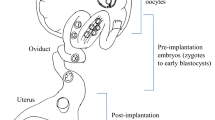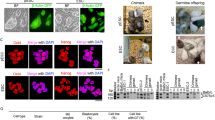Abstract
Advances in gene editing tools such as CRISPR/Cas9 have made precise in vivo gene editing possible, opening up avenues of research into somatic cell reprograming to study adult stem cells, homeostasis, and malignant transformation. Here we describe a method for CRISPR/Cas9 mediated in vivo gene editing, in combination with Cre-based lineage tracing via electroporation in the mouse oviduct. This method facilitates the delivery of multiple plasmids into oviduct epithelial cells, sufficient for studying homeostasis and generation of high-grade serous ovarian cancer (HGSOC) models.
Access this chapter
Tax calculation will be finalised at checkout
Purchases are for personal use only
Similar content being viewed by others
References
Varga J, Greten FR (2017) Cell plasticity in epithelial homeostasis and tumorigenesis. Nat Cell Biol 19(10):1133–1141
Doyle A, Mcgarry MP, Lee NA, Lee JJ (2013) The construction of transgenic and gene knockout/Knockin mouse models of human disease. Transgenic Res 21(2):327–349
Kersten K, De Visser KE, Van Miltenburg MH (2017) Genetically engineered mouse models in oncology research and cancer medicine. EMBO Mol Med 9(2):137–153
Heyer J, Kwong LN, Lowe SW, Chin L (2010) Non-germline genetically engineered mouse models for translational cancer research. Nat Rev Cancer 10(7):470–480
Kroeger PT, Drapkin R (2017) Pathogenesis and heterogeneity of ovarian cancer. Curr Opin Obstet Gynecol 29(1):26–34
The Cancer Genome Atlas Research Network (2012) Integrated genomic analyses of ovarian carcinoma. Nature:0–7
Almiñana C, Bauersachs S (2019) Extracellular vesicles in the oviduct: progress, challenges and implications for the reproductive success. Bioengineering 6(32):1–25
Li S, Winuthayanon W (2017) Oviduct: roles in fertilization and early embryo development. J Endocrinol 232:R1–R26
Maillo V, Sánchez-calabuig MJ, Lopera-vasquez R, Hamdi M, Gutierrez-adan A, Lonergan P et al (2016) Oviductal response to gametes and early embryos in mammals. Reproduction 152(1):R127–R141
Soong TR, Howitt BE, Miron A, Horowitz NS, Campbell F, Feltmate CM et al (2018) Evidence for lineage continuity between early serous proliferations ( ESPs ) in the fallopian tube and disseminated high-grade serous carcinomas. J Pathol 246(September):344–351
Medeiros F, Muto MG, Lee Y, Elvin JA, Callahan MJ, Feltmate C et al (2006) The tubal fimbria is a preferred site for early adenocarcinoma in women with familial ovarian Cancer syndrome. Am J Surg Pathol 30(2):230–236
Shaw PA, Rouzbahman M, Pizer ES, Pintilie M (2009) Candidate serous cancer precursors in fallopian tube epithelium of BRCA1/2 mutation carriers. Mod Pathol:1133–1138
Lee Y, Miron A, Drapkin R, Medeiros F, Saleemuddin A, Garber J et al (2007) A candidate precursor to serous carcinoma that originates in the distal fallopian tube. J Pathol 211(November 2006):26–35
Labidi-Galy SI, Papp E, Hallberg D, Niknafs N, Adleff V, Noe M et al (2017) High grade serous ovarian carcinomas originate in the fallopian tube. Nat Commun 8(1):1093. http://www.nature.com/articles/s41467-017-00962-1
Friedrich M, Heid I, Maresch R, Mueller S, Veltkamp C, Rupert O et al (2016) Multiplexed pancreatic genome engineering and cancer induction by transfection-based CRISPR / Cas9 delivery in mice. Nat Commun 7(10770):1–13
Teng K, Ford MJ, Harwalkar K, Li Y, Pacis AS, Farnell D, Yamanaka N, Wang YC, Badescu D, Ton Nu TN, Ragoussis J, Huntsman DG, Arseneau J, Yamanaka Y (2021) Modeling High-Grade Serous Ovarian Carcinoma Using a Combination of In Vivo Fallopian Tube Electroporation and CRISPR-Cas9-Mediated Genome Editing. Cancer Res 81(20):514–5160. https://doi.org/10.1158/0008-5472.CAN-20-1518. Epub 2021 Jul 23. PMID: 34301761
Wu SS, Lee J, Koo B (2019) Lineage tracing: computational reconstruction goes beyond the limit of imaging. Mol Cells 42(2):104–112
Chazaud C, Yamanaka Y, Pawson T, Rossant J (2006) Early lineage segregation between epiblast and primitive endoderm in mouse blastocysts through the Grb2-MAPK pathway. Dev Cell 10:615–624
Madisen L, Zwingman TA, Sunkin SM, Oh SW, Zariwala HA, Gu H, Ng LL, Palmiter RD, Hawrylycz MJ, Jones AR, Lein ES, Zeng H (2010) A robust and high-throughput Cre reporting and characterization system for the whole mouse brain. Neurosci 13(1):133–140. https://doi.org/10.1038/nn.2467. Epub 2009 Dec 20. PMID: 20023653; PMCID: PMC2840225.
Ford MJ, Yeyati PL, Jackson IJ, Mill P, Mort RL, Ford MJ et al (2018) A cell/cilia cycle biosensor for single-cell kinetics reveals persistence of cilia after G1 / S transition is a general property in cells and mice technology a cell / cilia cycle biosensor for single-cell kinetics reveals persistence of cilia after G1. Dev Cell 47(4):509–523.e5. https://doi.org/10.1016/j.devcel.2018.10.027
Mort RL, Ford MJ, Sakaue-sawano A, Lindstrom O, Casadio A, Douglas AT et al (2015) Fucci2a: a bicistronic cell cycle reporter that allows Cre mediated tissue specific expression in mice. Cell Cycle 4101
Livet J, Weissman TA, Kang H, Draft RW, Lu J, Bennis RA et al (2007) Transgenic strategies for combinatorial expression of fluorescent proteins in the nervous system. Nature 450(7166):56–62. http://www.ncbi.nlm.nih.gov/pubmed/17972876
Xie Y, Park E, Xiang D, Li Z (2018) Long-term organoid culture reveals enrichment of organoid-forming epithelial cells in the fimbrial portion of mouse fallopian tube. Stem Cell Res 32(February):51–60. https://doi.org/10.1016/j.scr.2018.08.021
Author information
Authors and Affiliations
Corresponding author
Editor information
Editors and Affiliations
Rights and permissions
Copyright information
© 2022 Springer Science+Business Media, LLC, part of Springer Nature
About this protocol
Cite this protocol
Ford, M.J., Yamanaka, Y. (2022). Reprogramming Mouse Oviduct Epithelial Cells Using In Vivo Electroporation and CRISPR/Cas9-Mediated Genetic Manipulation. In: Kannan, N., Beer, P. (eds) Stem Cell Assays. Methods in Molecular Biology, vol 2429. Humana, New York, NY. https://doi.org/10.1007/978-1-0716-1979-7_24
Download citation
DOI: https://doi.org/10.1007/978-1-0716-1979-7_24
Published:
Publisher Name: Humana, New York, NY
Print ISBN: 978-1-0716-1978-0
Online ISBN: 978-1-0716-1979-7
eBook Packages: Springer Protocols




